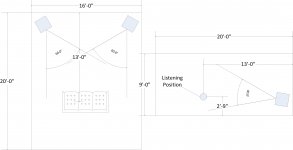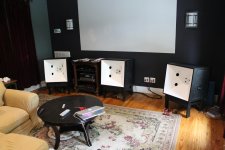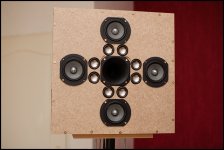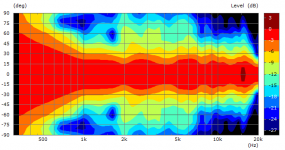Here's another vote for a Synergy design. At least in my case, how the speaker sounds when I'm NOT in the sweet seat also affects how well the illusion works. Nothing more artificial (to me at least) than having the sound go flat or swim around when you stand up or move a little, and you really can't turn off that subjective effect via mind control. Synergy horns sound like musicians are there even when you get up to go get a beer!
BTW, I think I remember some reference earlier it the thread to steering a CTC cancellation null at the floor to avoid reflections? I see this mentioned at times, but I doubt the null can be used as an advantageous thing like this -- it isn't very wide in frequency range, so it would work only over a small band. In other words, the null is wide enough to be a problem but too narrow to be used as a source of much directivity.
Regarding horns, I have yet to see mention of a horn that actually significantly impacts the first vertical reflection (from the floor). I have seen mention of placing the horn on the floor, but I suspect that sounds like it's on the floor, which doesn't appeal to me. (Correct me if I'm misinterpreting here. I don't know who is who, nor who has what variants of speakers at home.). There has been some discussion as to why horns usually don't have sufficient vertical directivity to attenuate the floor reflection (they would get very wide).
Regarding steering a null at the floor (and ceiling) if you look at the polar response image I attached to post 32, you will see that the null is carried across a very wide frequency range.
So in short, horn speakers (typically) don't significantly reduce the first vertical reflections, nor do traditional multi-way speakers, nor do the eXpanding arrays that have been implemented so far. But the approach I've detailed appears to have merit to accomplish exactly that, across a wide bandwidth in the middle of the audible frequency range.
But is this an important design goal?
Reading the prior related thread, it appears that it may nor may not be:
Perhaps eliminating the floor reflection removes an important acoustic clue our brains use to determine the height/distance of the source. Perhaps human brains will be very confused when a mostly-clean vertical reflection is missing, and imaging will drastically suffer as a result.
Or maybe we will barely even notice, because it just doesn't make much difference.
Or maybe we will barely notice because recordings include a prior vertical reflection (with less delay) that our brain picks up on and uses to localize the image.
Or maybe recordings (at least some of them) include a vertical reflection that happens LATER than our in-room floor reflection. Perhaps our brains ignore that information in favor of the prior reflection provided by our own floor. Perhaps eliminating that floor reflection allows us to apply imaging cues from the recording instead of our rooms, creating a significantly improved image, with the ability to be more diverse than we have previously heard.
Or perhaps the result will be an apparent change in tonal quality. Or not.
A lot of research appears to have treated all reflections the same, but there's some evidence that we don't process vertical and lateral reflections the same way. Thus reducing one may have different effects than reducing the other. Or not.
I'm still not convinced one way or the other, and I haven't joined one camp or another regarding this issue. I just think it's nice to have options.
Regarding horns, I have yet to see mention of a horn that actually significantly impacts the first vertical reflection (from the floor). I have seen mention of placing the horn on the floor, but I suspect that sounds like it's on the floor, which doesn't appeal to me. (Correct me if I'm misinterpreting here. I don't know who is who, nor who has what variants of speakers at home.). There has been some discussion as to why horns usually don't have sufficient vertical directivity to attenuate the floor reflection (they would get very wide).
In a Synergy design, within the basic limits achievable with a quadratic or conical horn flare coverage angle you choose your horizontal and vertical angles and point them where you want to put sound.
It's that simple.
Practically you'll want to stay within 1.5:1 or at MOST 2:1 between horizontal and vertical (or vertical to horizontal) and tap into the horn at the spots most beneficial for the driver. Keep the crossover points within 1/4 wavelength and the maximum distance between injection points within 1/4 wavelength and don't screw it up in the crossover: you'll have the ability to place a unified single wavefront controlled directivity wavefront that won't diverge as it travels to your listening position.
Let me state that again: A single wavefront that won't diverge.
In a normal non-coincident speaker the wavefront from each driver meets and sums to some level of correctness that varies by position and distance.
In a Synergy horn...they don't diverge. They are blended in the horn and propagate as a single unit towards the listener. (That's one of the reasons to call the predecessor horn the Unity Horn.)
I've attached a simple sketch of a 20' deep, 16' wide, 9' tall listening room. Listening distance is 13' from the back wall, listening height is 33" The Synergy Horns in the diagram are represented by the light blue boxes. They have coverage of 40V x 60H. Tilting the horns up 10 degrees and placing the apex of the throat at ~30 inches. Each horn is tilted in towards the center of the room 30 degrees.
Not one primary reflection, floor, ceiling, or sidewall will reach the listeners seated on an average 3 seat couch 13' from the back wall.
In addition you get the benefits of being able (if designed correctly) of being able to reproduce a square wave with pretty good fidelity (for a speaker) over a region of the speakers bandwidth.
You also get the ability to use lower cost drivers because the injection ports along the length of the horn serve as lowpass filters reducing the distortion. I have used $.75 2" drivers in speakers that will hit 105-110dB peaks at a listening position 10 feet away as midranges, and kept THD under 2%.
In my application the horns are lower to the ground than I would like, but it's not that objectionable. I did that to keep them from visually blocking the movie screen.
It took me almost 20 years to catch on to what was going on inside a Synergy/Unity. I'm sure there's some subtle bits I haven't discovered yet. You have to build a few to realize what's really happening with the injection point/throat reflections, injection air mass/reactance, phase rotation...etc.... but once you do....it'll be hard to think of speakers the same way.
Scott
Attachments
You could use an absorptive waveguide to help clean up the vertical combing "trails" that are near the pressure average.. a'la Duntech/Dunlavey & Lipinski.
I've had great results combining directivity devices (horns/waveguides) with absorbtion.
In a Synergy design, within the basic limits achievable with a quadratic or conical horn flare coverage angle you choose your horizontal and vertical angles and point them where you want to put sound.
It's that simple.
...
Let me state that again: A single wavefront that won't diverge.
...
once you do....it'll be hard to think of speakers the same way.
Scott
I'll take it you're just trying to help, but you are coming off a little like a salesman.
What does a horn look like with 360 degree H by 40 degree V look like? How about 180 H by 40 V? You even state that 90 by 40 is rather impractical, so if you determine that you don't like vertical reflections, but you like horizontal reflections, then a horn pretty much wont do the trick. Also, I didn't see dimensions listed for those horns: did they by any chance have directivity down to 400 hz? What kind of size would that necessitate?
With a vertical array, you can address the vertical reflections on the floor and ceiling (at least in my case since with a 7.75 foot basement ceiling the angles aren't that different) which are otherwise difficult to address with sound treatment. Then you can add the amount of treatment for horizontal reflections that makes you happy.
Personally, I haven't messed around with directivity in my theater yet, so I don't know my preferences. Things I have built so far have tried to be omni. Maybe at some point I'll end up with horns, but it's just not next on my to-try list.
I certainly wouldn't be adverse to hearing any type of directivity controlling speaker in the DC area, though.
Last edited:
I've had great results combining directivity devices (horns/waveguides) with absorbtion.
..Not one primary reflection, floor, ceiling, or sidewall will reach the listeners seated on an average 3 seat couch 13' from the back wall..
This depends entirely on the Synergy's passband/wavelength vs the size of the horn.
There is still likely to be significant output up to 800 Hz that could/would reflect with a design like the SH50 (in a small room context).
You could scale the design up a bit larger - but even then you won't lower the freq. that much.
To really get rid of most reflections to a lower freq. (in the midrange) you would likely need to integrate it into the corners of the room like a Klipschorn. At that point you would only be concerned with the ceiling and the back-wall (which could both be made absorptive to at least 150 Hz).
Personally, I haven't messed around with directivity in my theater yet, so I don't know my preferences. Things I have built so far have tried to be omni. Maybe at some point I'll end up with horns, but it's just not next on my to-try list.
I certainly wouldn't be adverse to hearing any type of directivity controlling speaker in the DC area, though.
Vertically "squashed": Unless its the product of a large array, the sound is usually vertically "challenged" (..images are generally "short" depending on the placement of the "line"), not unlike a small line source operating as a line source within it's passband (..see Dr. Griffin's paper on line arrays).
Horns tend to sound like in-wall designs with some more obvious colorations.
..at least that's been my experience, and only the JMLC horn listened to off-axis (and operated an octave or more above it's cutoff) seems to really "buck" this trend. (..shallow waveguides are often quite different as well, and of course usually do not operate nearly as low in freq.. which can cause problems with nulls on the vertical axis.)
Enhanced vertical directivity in a Theater context can be very good.
Last edited:
This depends entirely on the Synergy's passband/wavelength vs the size of the horn.
There is still likely to be significant output up to 800 Hz that could/would reflect with a design like the SH50 (in a small room context).
You could scale the design up a bit larger - but even then you won't lower the freq. that much.
To really get rid of most reflections to a lower freq. (in the midrange) you would likely need to integrate it into the corners of the room like a Klipschorn. At that point you would only be concerned with the ceiling and the back-wall (which could both be made absorptive to at least 150 Hz).
Note that my speakers are towards the corners...but yes...below the directivity limit imposed by the circumference of the horn mouth it will lose directivity and the sound can "see" the room boundaries. Physics sucks.
I'll take it you're just trying to help, but you are coming off a little like a salesman.
Sorry, just trying to be emphatic. It's true though, the wavefronts don't diverge.
What does a horn look like with 360 degree H by 40 degree V look like? How about 180 H by 40 V? You even state that 90 by 40 is rather impractical, so if you determine that you don't like vertical reflections, but you like horizontal reflections, then a horn pretty much wont do the trick. Also, I didn't see dimensions listed for those horns: did they by any chance have directivity down to 400 hz? What kind of size would that necessitate?
60x40, 400 Hz ~= 31" wide, 21" tall.
60x40, 800 Hz ~= 15" wide, 11" tall.
Bill Waslo has a link in his signature to a spreadsheet that helps you with the miter angles, mouth size and coverage angles/frequency. Check it out. He's the author of IMP, LAUD, Praxis and OmniMic. He's pretty good at this stuff...
Anything beyond 2:1 and you start running into issues with maintaining pattern control and overall impedance matching at the injection points. If you don't like vertical reflections, I'm not sure why horizontal reflections are so beneficial?....
With a vertical array, you can address the vertical reflections on the floor and ceiling (at least in my case since with a 7.75 foot basement ceiling the angles aren't that different) which are otherwise difficult to address with sound treatment. Then you can add the amount of treatment for horizontal reflections that makes you happy.
I've never had room treatments + wide dispersion that come close to the performance I get with the Synergy concept. I've had absorption, diffusion and everything in between.....still have some of it. I'll be selling though...don't need it.
Personally, I haven't messed around with directivity in my theater yet, so I don't know my preferences. Things I have built so far have tried to be omni. Maybe at some point I'll end up with horns, but it's just not next on my to-try list.
I certainly wouldn't be adverse to hearing any type of directivity controlling speaker in the DC area, though.
If you visit central Texas, and want to hear mine....PM me. I'll treat you to some wine or whiskey if that's your poison. I'll warn you though...most leave the listening room unsatisfied with what they have, much like taking a class on glassware from George Reidel complicated my wine drinking, I tend to complicate peoples listening experience.
-Scott
Listen to a conventional mono recording. With your goals in mind it could sound just as an open window in front of you would. Centre performers in a stereo recording will be as well placed, or should I say.. free from lateral distractions.bbutterfield said:Perhaps eliminating the floor reflection removes an important acoustic clue our brains use to determine the height/distance of the source. Perhaps human brains will be very confused when a mostly-clean vertical reflection is missing, and imaging will drastically suffer as a result.
Or maybe we will barely even notice, because it just doesn't make much difference.
Or maybe we will barely notice because recordings include a prior vertical reflection (with less delay) that our brain picks up on and uses to localize the image.
I will notice the floor in a recording booth, on such recordings, before I notice my own floor. Consistently.
It is important in the lower treble due to our sensitivity. It is important in the lower midrange because it becomes hard to treat. Below this it is just another room mode.
For me, this works (in a hard room). Controlled directivity, but with a much wider radiation pattern than a waveguide or horn. Between 0 and 30 degrees off axis, the sound of my speakers does not change appreciably, between 30 and 60 degrees some, and even from slightly behind the speaker at 110 degrees, the sound is still listenable.
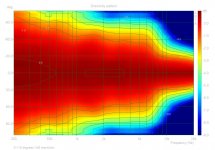
Advantages: the whole room is in the sweet spot and there is pin point stereo imaging in a wide listening area. The Haas effect is truly amazing in neutralizing reflections.

Advantages: the whole room is in the sweet spot and there is pin point stereo imaging in a wide listening area. The Haas effect is truly amazing in neutralizing reflections.
The directivity of the main lobe in post 32 is pretty nice, but the strength of the many 'parasitic' lobes.... not so much. Doesn't that sound sort of like a flutter echo? Or are the reflections from those narrow enough or late enough to not be a problem?
I agree about the vertical control being a problem with most horn speakers in general, though. In my (very challenged, 7 foot ceiling, basement) listening room, I have the ceiling stuffed between beams with deep absorbent, which works better than I would have expected. No idea how much better it might sound if the reflection control were more complete, though.
I have a revised Synergy horn planned that better addresses vertical control (vertical control is partly a function of horn height and narrow tall speakers are usually practical in a room). The issue (for a Synergy with linear phase pretentions) is to keep the z (depth) position of all the drivers constant. I want to try by having the horn depth be different for horizontal and vertical.

Sadly, low physical endurance and just-plain-laziness (and recently changing cities, and a recent obsession with amplifiers) have all kept me from actually trying to build the beasts!
Scott, have you tried skipping the center channel and using phantom center? That would let you raise the horns to ear level. In my setup, the phantom center sounds better to me than even images that are placed hard into L or R, so I haven't gotten any enthusiasm for a center channel (and I don't even have a screen to deal with).
I agree about the vertical control being a problem with most horn speakers in general, though. In my (very challenged, 7 foot ceiling, basement) listening room, I have the ceiling stuffed between beams with deep absorbent, which works better than I would have expected. No idea how much better it might sound if the reflection control were more complete, though.
I have a revised Synergy horn planned that better addresses vertical control (vertical control is partly a function of horn height and narrow tall speakers are usually practical in a room). The issue (for a Synergy with linear phase pretentions) is to keep the z (depth) position of all the drivers constant. I want to try by having the horn depth be different for horizontal and vertical.

Sadly, low physical endurance and just-plain-laziness (and recently changing cities, and a recent obsession with amplifiers) have all kept me from actually trying to build the beasts!
Scott, have you tried skipping the center channel and using phantom center? That would let you raise the horns to ear level. In my setup, the phantom center sounds better to me than even images that are placed hard into L or R, so I haven't gotten any enthusiasm for a center channel (and I don't even have a screen to deal with).
The directivity of the main lobe in post 32 is pretty nice, but the strength of the many 'parasitic' lobes.... not so much. Doesn't that sound sort of like a flutter echo? Or are the reflections from those narrow enough or late enough to not be a problem?
I agree about the vertical control being a problem with most horn speakers in general, though. In my (very challenged, 7 foot ceiling, basement) listening room, I have the ceiling stuffed between beams with deep absorbent, which works better than I would have expected. No idea how much better it might sound if the reflection control were more complete, though.
I have a revised Synergy horn planned that better addresses vertical control (vertical control is partly a function of horn height and narrow tall speakers are usually practical in a room). The issue (for a Synergy with linear phase pretentions) is to keep the z (depth) position of all the drivers constant. I want to try by having the horn depth be different for horizontal and vertical.
Sadly, low physical endurance and just-plain-laziness (and recently changing cities, and a recent obsession with amplifiers) have all kept me from actually trying to build the beasts!
Scott, have you tried skipping the center channel and using phantom center? That would let you raise the horns to ear level. In my setup, the phantom center sounds better to me than even images that are placed hard into L or R, so I haven't gotten any enthusiasm for a center channel (and I don't even have a screen to deal with).
Bill,
That's an interesting take on a Synergy for a home design. The number of miters would make the enclosure an awful lot of fun to build. Or...really really annoyingly difficult. Or both.
In that design it looks like you'll be sacrificing horn loading impedance match since the expansion in the horizontal direction is so fast when then sides end. In the vertical direction you'll maintain directivity due to the waveguide function. For a home Synergy it'll be almost no issue, since the listening distances and output required rarely requires full use of the horn loading/impedance matching efficiency gains possible through proper integration of the injection ports/drivers/location.
In other words....it won't play as loud, but that's okay, if you use the full output of the full Synergy horn in a residential setting you'll likely be making yourself as deaf as a post.
As far as the phantom center channel...no...it never even dawned on me to try it. The center image is so strong that it would likely work very well. I might have to rig up some temporary higher stands and give that a try.
There is a SAF issue with it though...as they will likely be higher and more visually intrusive.
Scott
As far as the phantom center channel...no...it never even dawned on me to try it. The center image is so strong that it would likely work very well. I might have to rig up some temporary higher stands and give that a try.
Scott
Have you checked to see if you'll be able to eliminate the floor reflections up on a stand, as you described in an earlier post for a theoretical horn? I'd be very interested in your impressions if you can.
@bbutterfield
Horbach and Keele developed filters which shape the vertical directivity of a multi-way speaker. The drivers must be aligned pairwise with special distance to the midpoint. It works well with 4 ways. I'm working on a 2D version of this concept and it is very promising.
The only problem is the tweeter which is alone and doesn't come in a pair. To get a nearly constant directivity it must be horn loaded. But this horn can be pretty small (I use 12 cm diameter).
The filters must be linear phase which means FIR. But with RePhase and a MiniSharc or BruteFIR the costs are rather low.
Here is my prototype I'm working on. The 4th way (bass) is not implemented yet and will only be vertically paired to save width.
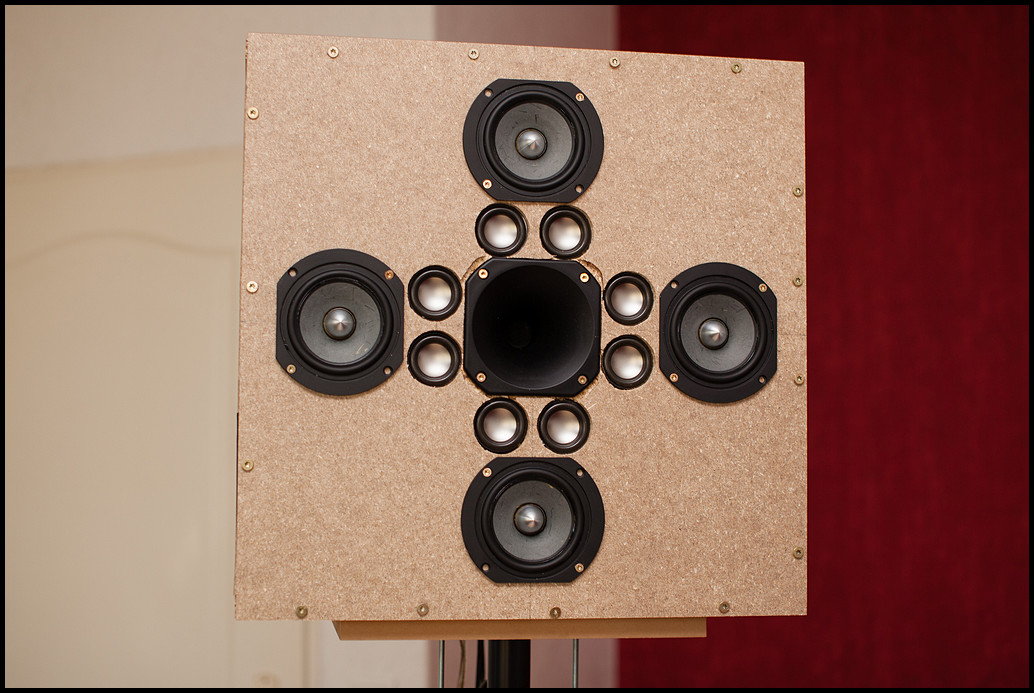
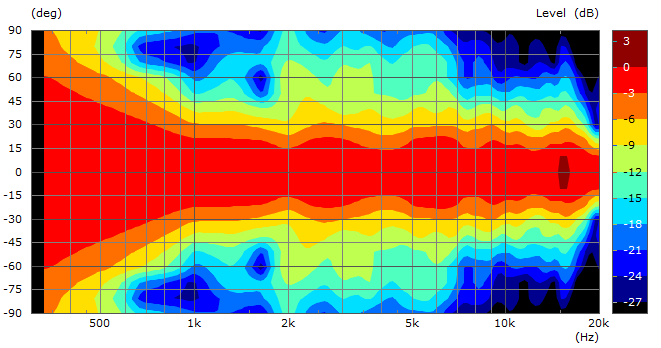
With this concept you get a speaker with narrow directivity in both directions without using big horns. The enclosure can be flat and there are no big problems with horn resonances. It even works very good in nearfield, because of the coax design. SPL is high and distortion is low, because of the high number of drivers. Of course this is also a drawback. The speaker will not be cheap.
Horbach and Keele developed filters which shape the vertical directivity of a multi-way speaker. The drivers must be aligned pairwise with special distance to the midpoint. It works well with 4 ways. I'm working on a 2D version of this concept and it is very promising.
The only problem is the tweeter which is alone and doesn't come in a pair. To get a nearly constant directivity it must be horn loaded. But this horn can be pretty small (I use 12 cm diameter).
The filters must be linear phase which means FIR. But with RePhase and a MiniSharc or BruteFIR the costs are rather low.
Here is my prototype I'm working on. The 4th way (bass) is not implemented yet and will only be vertically paired to save width.
With this concept you get a speaker with narrow directivity in both directions without using big horns. The enclosure can be flat and there are no big problems with horn resonances. It even works very good in nearfield, because of the coax design. SPL is high and distortion is low, because of the high number of drivers. Of course this is also a drawback. The speaker will not be cheap.
Attachments
Simulation of 4-way WWMmmTMWW. Drivers are 1", 2x4", 2x6.5" and 4x10". X/O is common phase aligned IR as you can see. Off-axis responses are simulated by piston radius and baffle diffraction.
DI in vertical plane only (right scale).
This works just fine when properly designed.
An externally hosted image should be here but it was not working when we last tested it.
DI in vertical plane only (right scale).
An externally hosted image should be here but it was not working when we last tested it.
This works just fine when properly designed.
Last edited:
This works just fine when properly designed.
It works ok, but there are still problems to solve. Vertically the tweeter is always a problem, because its dispersion is very wide in its lower range. The vertical DI shows this as a 5 dB drop between 4 - 12 kHz.
Above that the tweeter's dispersion is very narrow. The overall DI shows this behaviour. DI is going up 7,5 dB from 10 kHz to 20 kHz.
A small horn solves both problems.
^Don't care about tweeter. Idea was not to simulate what kind of tweeter you should or must select to this concept.
You should care. The tweeter's dimension restricts other parameters of the concept. Both can not be considered separately.
^Argh! That was just a simulation without any instruction what kind of tweeter is best for this application, environment and listener. You can select small horn if you like. I would not because I'm done with horns.
This is with 15x40mm planar, which could be my selection:
This is with 15x40mm planar, which could be my selection:
An externally hosted image should be here but it was not working when we last tested it.
- Status
- This old topic is closed. If you want to reopen this topic, contact a moderator using the "Report Post" button.
- Home
- Loudspeakers
- Multi-Way
- Preferred / Ideal Directionality
